Honda Accord
| Honda Accord | |
|---|---|
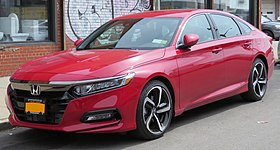 2018 Honda Accord | |
| Overview | |
| Manufacturer | Honda |
| Production | 1976–present |
| Body and chassis | |
| Class | Compact car (1976–1989) Mid-size car (1989–present) |
| Layout | Front-engine, front-wheel-drive |
The Honda Accord (Japanese: ホンダ・アコード Honda Akōdo) /əˈkɔːrd/ is a series of automobiles manufactured by Honda since 1976, best known for its four-door sedan variant, which has been one of the best-selling cars in the United States since 1989. The Accord nameplate has been applied to a variety of vehicles worldwide, including coupes, wagons, hatchbacks, and a crossover.
Contents
- 1 Background
- 2 First generation (1976–1981)
- 3 Second generation (1981–1985)
- 4 Third generation (1985–1989)
- 5 Fourth generation (1989–1993)
- 6 Fifth generation (1994–1997)
- 7 Sixth generation (1997–2002)
- 8 Seventh generation (2002–2007)
- 9 Eighth generation (2007–2012)
- 10 Ninth generation (2013-2017)
- 11 Tenth generation (2018–present)
- 12 Awards
- 13 Motorsport
- 14 Competition
- 15 Sales
- 16 References
- 17 External links
Background[edit]
Since initiation, Honda has offered several different car body styles and versions of the Accord, and often vehicles marketed under the Accord nameplate concurrently in different regions differ quite substantially. It debuted in 1976 as a compact hatchback, though this style only lasted through 1989, as the line-up was expanded to include a sedan, coupe, and wagon. By the Accord's sixth generation at the end of the 1990s, it evolved into an intermediate vehicle, with one basic platform but with different bodies and proportions to increase its competitiveness against its rivals in different international markets. For the eighth generation of the Accord released for the North America market in 2007, Honda had again chosen to move the model further up-scale and increase its size.[1] This pushed the Accord sedan from the upper limit of what the U.S. Environmental Protection Agency (EPA) defines as a mid-size car to just above the lower limit of a full-size car,[2] with the coupe still rated as a mid-size car. In 2012, the ninth-generation Accord sedan, with smaller exterior dimensions, was once again classified as a mid-size car at 119 cubic feet (3.4 m3), falling just shy of the "Large Car" classification. However, the current 10th-generation Accord, with similar exterior dimensions, returned to full-size car status with its combined interior space of 123 cubic feet (3.5 m3). The coupe has since been discontinued.
After a period of developing idiosyncratic automobiles such as the Honda 1300 that met a lukewarm response in both Japan and North America, Honda considered pulling out of automobile manufacturing altogether by the early 1970s. However, Honda released a more conventional automobile in 1972 called the "Civic" which immediately reversed their flagging fortunes due to its economy, reliability and low cost in an era of rising fuel prices. The Civic utilized Honda's CVCC technology, later used in the Accord, to help Honda meet emission standards of the 1970s and early 1980s without the added expense of a catalytic converter.[3]
Buoyed by their success with the Civic, Honda turned their sights to developing a larger companion model. For the new model, Honda chose the name "Accord", reflecting "Honda's desire for accord and harmony between people, society and the automobile."[4] German manufacturer Opel unsuccessfully sued Honda, claiming that the name was too similar to their Rekord.[5]
Soichiro Honda was the owner of a 1969 Pontiac Firebird, to which the Accord's predecessor, the Honda 1300, bore a striking frontal resemblance.[3] Initial planning done by Honda for what would become the Accord was for a sporty competitor in the pony car market, at roughly the size of a contemporary Ford Mustang, powered by a six-cylinder engine.[6]
With the continuing fuel crisis and tighter emissions regulations surrounding the automotive market, Honda engineers changed their focus on the Accord as a Mustang competitor, and built upon the Civic's successful formula of economy, fuel efficiency and a front-wheel drive layout in a larger package.[7] A December 1975 issue of Motor Trend Magazine had a drawing of a new Honda automobile which was similar in shape to the Volkswagen Scirocco but powered with a CVCC engine used in the Civic. In reality, the design of the Accord was finalized in the fall of 1973 weeks prior to the debut of the Scirocco, which debuted in January 1974. [8]
In 1982, the Accord became the first car from a Japanese manufacturer to be produced in the United States when production commenced in Marysville, Ohio at Honda's Marysville Auto Plant. The Accord has achieved considerable success, especially in the United States, where it was the best-selling Japanese car for sixteen years (1982–97), topping its class in sales in 1991 and 2001, with around ten million vehicles sold.[9] Numerous road tests, past and present, rate the Accord as one of the world's most reliable vehicles.[10] The Accord has been on the Car and Driver 10Best list a record 30 times.[11]
In 1989, the Accord was the first vehicle sold under an import brand to become the best-selling vehicle in the United States.[12]
First generation (1976–1981)[edit]
| First generation series SJ-SM | |
|---|---|
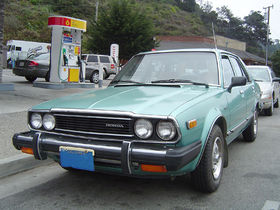 | |
| Overview | |
| Production | 1976–1981 |
| Assembly | Sayama Plant, Sayama, Saitama, Japan North Jakarta, Indonesia (PT. Prospect Motor) Johor Bahru, Malaysia (OASB)[13] |
| Body and chassis | |
| Class | Compact car |
| Body style | 3-door hatchback 4-door sedan |
| Powertrain | |
| Engine | 1.6 L EL1 I4 1.6 L EF I4 1.6 L EP I4 1.8 L EK1 I4 |
| Transmission | 2-speed automatic 3-speed automatic 5-speed manual |
| Dimensions | |
| Wheelbase | 2,380 mm (94 in) sedan |
| Length | 4,450 mm (175 in) sedan |
| Width | 1,620 mm (64 in) sedan |
| Height | 1,360 mm (54 in) sedan |
| Curb weight | 945 kg (2,083 lb) |
The first generation Honda Accord was launched on 7 May 1976 as a three-door hatchback with 68 hp (51 kW), a 93.7-inch (2,380.0 mm) wheelbase, and a weight of about 2,000 pounds. Japanese market cars claimed 80 PS (59 kW) JIS (similar to SAE Gross), while European and other export markets received a model without emissions control equipment; it claimed 80 PS as well but according to the stricter DIN norm. It was a platform expansion of the earlier Honda Civic at 4,125 mm (162 in) long. To comply with recently enacted emission regulations enacted in Japan, the engine was fitted with Honda's CVCC technology. The Accord sold well due to its moderate size and great fuel economy. It was one of the first Japanese sedans with features like cloth seats, a tachometer, intermittent wipers, and an AM/FM radio as standard equipment. In 1978 an LX version of the hatchback was added which came with air conditioning, a digital clock, and power steering. Until the Accord, and the closely related Prelude, power steering had not been available to cars under two liters.[14] Japanese buyers were liable for slightly more annual road tax over the smaller Civic, which had a smaller engine.
On 14 October 1977 (a year later in the US market), a four-door sedan was added to the lineup, and power went to 72 hp (54 kW) when the 1,599 cc (97.6 cu in)[15] EF1 engine was supplemented and in certain markets replaced by the 1,751 cc (106.9 cu in) an EK-1 unit. In 1980 the optional two-speed semi-automatic transmission of previous years became a three-speed fully automatic gearbox (a four-speed automatic transaxle was not used in the Accord until the 1983 model year). The North American versions had slightly redesigned bumper trim. Other changes included new grilles and taillamps and remote mirrors added on the four-door (chrome) and the LX (black plastic) models. The CVCC badges were deleted, but the CVCC induction system remained.
In North America, the 1981 model year only brought detail changes such as new fabrics and some new color combinations.[16] Nivorno Beige (code No. Y-39) was replaced by Oslo Ivory (No. YR-43). Dark brown was discontinued, as was the bronze metallic. A bit later in 1981 an SE model was added for the first time, with Novillo leather seats and power windows. Base model hatchbacks, along with the four-door, LX, and SE four-door, all received the same smaller black plastic remote mirror. The instrument cluster was revised with mostly pictograms which replaced worded warning lights and gauge markings. The shifter was redesigned to have a stronger spring to prevent unintentional engagement of reverse, replacing the spring-loaded shift knob of the 1976 to 1980 model year cars. By 1981 power for the 1.8 was down to a claimed 68 hp (51 kW) in North America.[16]
Second generation (1981–1985)[edit]
| Second generation series SY/SZ/AC/AD | |
|---|---|
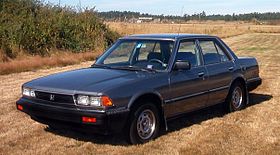 | |
| Overview | |
| Also called | Honda Vigor (Japan) |
| Production | 1981–1985 |
| Assembly | Sayama, Saitama, Japan Marysville, Ohio, United States (Marysville Auto Plant) Nelson, New Zealand (Honda New Zealand) North Jakarta, Indonesia (PT. Prospect Motor) Johor Bahru, Malaysia (OASB)[13] |
| Designer | Yukio Kurosu (1979)[17] |
| Body and chassis | |
| Class | Compact car |
| Body style | 3-door hatchback 4-door sedan |
| Powertrain | |
| Engine | |
| Transmission |
|
| Dimensions | |
| Wheelbase | 2,450 mm (96 in) sedan |
| Length | 4,410 mm (174 in) sedan |
| Width | 1,650 mm (65 in) sedan |
| Height | 1,375 mm (54 in) sedan |
Debuting on 22 September 1981 in Japan, Europe, and in North America, this generation of the Accord being produced in Japan, also became the first to be built in the United States, at Honda's plant in Marysville, Ohio. Since its first year in the American market, it also became the best-selling Japanese nameplate in the United States, retaining that position for about 15 years.[18] In Japan, a sister model called the Honda Vigor was launched simultaneously with the new Accord. This allowed Honda to sell the product at different sales channels called Honda Clio, which sold the Accord, and Honda Verno, that sold the Vigor.
Modernizing the interior and exterior, the second generation Accord was mechanically very similar to the original, using the same 1,751 cc (1.751 L; 106.9 cu in) EK-1 CVCC engine in the Japanese market. Vehicles with a manual transmission and the CVCC carburator earned 13.6 km/L (38 mpg‑imp; 32 mpg‑US) based on Japanese Government emissions tests using 10 different modes of scenario standards, and 110 PS (81 kW; 108 bhp), and 23 km/L (65 mpg‑imp; 54 mpg‑US) with consistently maintained speeds at 60 km/h. European market cars received the tested 1.6-liter EL1 engine with 80 PS (59 kW; 79 bhp) at 5000 rpm.[19]
This automobile included popular features of the time such as shag carpet, velour cabin trim, and chrome accents. An optional extra on the 1981 Accord was an Electro Gyrocator, the world's first automatic in-car navigation system.[20] Models were available in Silver, Sky Blue, and Beige. The LX hatchback offered a digital clock and slightly higher fuel economy (due to its lighter weight). In Europe, the Accord was available as a fairly well equipped (for the time) standard version, as well as a very luxurious EX model at a modest upcharge.[19]
In the United States, Federal lighting regulations required headlamps of sealed beam construction and standard size and shape on all vehicles, so Accords in North America were equipped with four rectangular headlamp units rather than the aerodynamic composite replaceable-bulb units used on Accords sold outside North America (note European specification imagery). Other Automotive lighting variations included amber front and red rear side marker lights and reflectors in North America, and headlamp washers and a red rear fog lamp for European markets. Japanese-market Accords were unique from all other markets in that they offered adjustable ride height control and side view mirrors installed on the mid-forward fenders.[21]
In November 1982, Honda made a fully four-speed automatic available with the 1.8-liter engine, a major improvement over the earlier, three-speed semi-automatic "Hondamatic" transmission. This quickly filtered through to export markets, where the outdated Hondamatic was soon superseded entirely. The manual five-speed transmission remained unchanged. A new 120 mph speedometer replaced the earlier 88 mph unit. The Special Edition (SE) featured Novillo leather seating, power windows, power sunroof and door locks. Gray was added as a color option. A slightly modified EK-2 engine was introduced, replacing the earlier EK-1, albeit still carbureted.
1983 refresh (1984 model year)[edit]
By 1983, Accords sold in the eastern United States were produced at the new Marysville plant, with quality considered equal to those produced in Japan. In June 1983, for the 1984 model year, the Accord body was restyled with a slightly downward beveled nose and a new series of 12-valve CVCC powerplants.[22] Globally there was a 1.6 (EY) and also the slightly more powerful ES2 1,829 cc (1.829 L; 111.6 cu in), yielding 86 bhp (64 kW) in federal trim. Honda integrated rear side marker lights and reflectors into the side of the tail light units. European Accords now included a side turn signal repeater just behind each front wheel well. The U.S. requirement for standardized headlamps was rescinded in late 1983, but North American Accords continued to use sealed beams until the fourth-generation models were released in 1989.
The LX offered velour upholstery, auto-reverse cassette stereo, air conditioning, cruise control, power brakes, power steering, power windows and power door locks (sedan only), a digital clock, roof pillar antenna, along with thick black belt moldings, integrated bumpers and flush plastic mock-alloy style wheels covers that resembled the trend-setting Audi 5000. Supplies were tight, as in the Eastern states, the wait was months for a Graphite Gray sedan, a then-popular color. The LX hatchback was the only 1984 version of the Accord to include dual side view mirrors.[citation needed]
The 1984 sedan was available in four exterior colors, Greek White and three metallic options: Columbus Gray, Regency Red (burgundy), and Stratos Blue (steel). The regular hatchback was available in Greek White, Dominican Red, and the metallic Stratos Blue. The 1984 LX hatchback came in three metallic colors only: Graphite Gray, Regency Red, and Copper Brown.
It was one of the first Japanese engineered vehicles to offer computer controlled, fuel-injection with one injector per cylinder, also known as multiple port fuel injection. This arrived on 24 May 1984 on the ES series 1.8 L engine, and was known as Honda's Programmed Fuel Injection, or PGM-FI.[23] This option was not offered until 1985 in the United States market. Vehicles with PGM-FI (ES3 series engine) earned 13.2 km/L (37 mpg‑imp; 31 mpg‑US) based on Japanese Government emissions tests using 10 different modes of scenario standards, with 130 PS (95.6 kW; 128.2 bhp), and 22 km/L (62 mpg‑imp; 52 mpg‑US) with consistently maintained speeds at 60 km/h (37.3 mph).[24]
In 1985, the Special Edition returned as the SE-i, capitalizing on the final year of the second generation's production. A fuel-injected, 110 bhp (82 kW) non-CVCC ES3 engine was exclusive to this model. The moniker, SE-i, was adapted from the SE trim, but included the "-i" to signify the higher trim level's fuel-injected engine. This 12-valve, 1,829 cc (1.829 L; 111.6 cu in) engine was the first non-CVCC engine used in an Accord, and was the same basic engine design used by Honda until 1989. Like the previous SE trim in 1983, the SE-i featured Novillo leather seating, power moonroof, bronze tinted glass, a premium sound system with cassette, and 13-inch alloy wheels. The level of luxury equipment on the SE-i was essentially items that were installed on the Honda Vigor VTL-i, that was only sold in Japan.
Available options differed from market to market. The 1.8-liter engine, updated four-speed automatic transmission, and 'EX' trim level options were first made available in New Zealand during the 1984 model year refresh alongside the 1.6-liter 'LX' model.
Japan generally received more options earlier than the rest of the world. In 1981, the Accord offered an adjustable ride height air suspension in the Japanese market. From 1983 in Japan and 1984 in Europe, the second generation Accord was available with anti-lock brakes (called ALB) as an option. This braking system was the first time that an Accord used four-wheel disc brakes. Fuel injection became available in 1984 in the Japan market with the earlier introduction of the ES3 engine in the SE-i. Models took a year to arrive in North American and European markets with less stringent emissions laws continuing, using carburetors throughout second generation production.
Third generation (1985–1989)[edit]
| Third generation series CA1/2/3/4/5/6 | |
|---|---|
 Accord DX sedan | |
| Overview | |
| Also called | Honda Vigor (Japan) |
| Production | 1985–1989 |
| Assembly | Sayama, Saitama, Japan Marysville, Ohio, USA (Marysville Auto Plant) Alliston, Ontario, Canada (HCM) Petone/Nelson, New Zealand (New Zealand Motor Corporation/Honda New Zealand) Ayuthaya, Thailand (Honda Cars (Thailand) Co.) North Jakarta, Indonesia (PT. Prospect Motor) Johor Bahru, Malaysia (OASB)[13] |
| Designer | Toshi Oshika (1983) |
| Body and chassis | |
| Class | Compact car |
| Body style | 2-door coupe 3-door hatchback 3-door shooting-brake (AeroDeck) 4-door sedan |
| Powertrain | |
| Engine | 1.6L A16A1 I4, 88 hp (66 kW) 1.8L A18A I4, 100 hp (75 kW) 1.8L B18A I4, 115 hp (86 kW) 2.0L A20A/A20A1/A20A2 I4, 98–108 hp (73–81 kW) 2.0L A20A3/A20A4 I4, 110–122 hp (82–91 kW) 2.0L B20A I4, 145 hp (108 kW) 2.0L B20A2 I4, 137 hp (102 kW) 2.0L B20A8 I4, 133 hp (99 kW) |
| Transmission | 4-speed automatic 5-speed manual |
| Dimensions | |
| Wheelbase | 2,601 mm (102.4 in) |
| Length | Hatchback: 4,440 mm (174.8 in) 1985–1987 Sedan: 4,549 mm (179.1 in) 1987–1989 Sedan & Coupe: 4,564 mm (179.7 in) |
| Width | Hatchback & Coupe: 1,694 mm (66.7 in) Sedan: 1,712 mm (67.4 in) |
| Height | Hatchback & Coupe: 1,336 mm (52.6 in) Sedan: 1,356 mm (53.4 in) |
The third generation Accord was introduced in Japan on 4 June 1985 and in Europe and North America later that year. It had a very striking exterior design styled by Toshi Oshika in 1983, that resonated well with buyers internationally. One notable feature was the hidden headlamps. Because this generation was also sold as the Honda Vigor, the Accord received the hidden headlamps. Honda's Japanese dealership channel called Honda Verno all had styling elements that helped identify products only available at Honda Verno. As a result, Japanese market Accords had a Honda Verno styling feature, but were sold at newly established Japanese dealerships Honda Clio with the all-new, luxury Honda Legend sedan, and international Accords were now visually aligned with the Prelude, the CR-X, and the new Integra.
The retractable headlamps of the third generation Accord sedan were in Japan, USA, Canada, Australia, New Zealand, KY region (Arabian countries) and on cars in Taiwan that were imported from the United States. In other countries, the Accord sedan had conventional headlamps, including in Japan from July 1987 on "Accord CA", with CA standing for "Continental Accord". Accords in all other bodies (hatchback, Aerodeck, coupe) had only retractable headlamps worldwide.
At its introduction in 1985, it won the Car of the Year Japan Award.
The third generation Accord became the first Honda to employ double wishbones at both the front and rear ends. While more expensive than competitors' MacPherson strut systems, this setup provided better stability and sharper handling for the vehicle. All had front sway bars and upper models had rear sway bars as well. Brakes were either small all-wheel discs with twin-piston calipers (only available on the Japanese-market 2.0-Si model), larger all-wheel discs with single piston calipers, or a front disc/rear drum system. ABS was available as an option on the 4-wheel disc brake models, though not in North America. Base model Accords rode on 13-inch steel wheels with hubcaps with more expensive models having the option of 14-inch alloy wheels.
The Accord's available engines varied depending on its market: Japan received the A18A, A20A, B18A, B20A and A20A3 (US imported cars); Europe received the A16A1, A20A1, A20A2, A20A3, A20A4, B20A2, and B20A8; Australia and New Zealand received A20A2 and A20A4; other regions received A20A2 and/or A16A1; while United States, Canada and Taiwan (US imported cars) received the A20A1 and A20A3. On Accord 1986 model year engine block was marked as BS and BT in the United States, BS1 and BT1 in Canada, this cars had chassis code BA. Since 1987 the engine block in Indonesia was marked as NA instead of A20A2. The engine block in Thailand was marked as A.
In Japan, the introduction of a 2.0 liter engine obligated Japanese drivers to pay a higher amount of annual road tax compared to the last two previous generations, pushing the Accord into the luxury category in Japan.
The Accord's trim levels ranged from spartan to luxurious. In the Japanese home market, the Accord was available with a full power package, heated mirrors (optional), a digital instrument cluster (optional), sunroof (optional), cruise control, and climate control (which was also optional). Some North European export models also had heated front seats and head light washers. North American and Australian Accords were not available with most of these options, presumably (and in the U.S. in particular) because Honda was seen as a builder of economy cars, and not to cannibalize sales from the recently introduced Acura line.
Throughout the different markets, in addition to the sedan model the Accord was available with different bodystyles which included a three-door hatchback, a three-door shooting-brake called Accord Aerodeck, and a two-door coupe which was added in 1987 for the 1988 model year. The coupe, which was built exclusively in Honda's Marysville, Ohio factory, was "reverse exported" back to Japan where it was known as the US-coupe CA6.
Accord AeroDeck[edit]
The third-generation Accord was sold in Japan, Europe and New Zealand as a three-door hatchback with a flat roof over the rear seats, known in Europe as a shooting-brake. The bodystyle of a flat roof hatchback was also used on the third generation Honda Civic (third generation) subcompact, the second generation Honda City supermini and the first generation Honda Today kei car. The Honda CR-X was the only three-door hatchback that adopted a fastback, sloping rear hatch "kammback" appearance, demonstrating a performance car appearance identified with Honda Verno products during the mid-1980s.
In North America, the Accord coupe and hatchback models were offered instead. The "Aerodeck" name was reused on the Honda Civic 5-door stationwagon (station wagon), sold in the UK from 1996 to 2000. In parts of Continental Europe, the Accord five-door station wagon (station wagon) was also called the Accord Aerodeck from 1990 until 2008, when the name of the station wagon was renamed the "Accord Tourer".[25] The Aero Deck was only available in Japan at Honda Clio dealerships as a variation of the Accord.
The cargo handling abilities of the Aero Deck were ceded to the fourth generation Accord station wagon (station wagon) in 1990. The Aero Deck was unique to the Accord model line, as the Aero Deck was not available as a Honda Vigor, as the Accord and Vigor were mechanically identical. The AeroDeck returned an aerodynamic value of .34, and the 2600 mm wheelbase returned a spacious interior for both front and rear passengers, on par with a mid-size sedan. Unfortunately, the appearance was not well received in Japan, as the introduction of the Accord Coupe was more well liked. The appearance was more popular in the United Kingdom.
The Aerodeck was equipped with a four-wheel double wishbone suspension, which gave both a comfortable ride and cornering performance. In addition, speed-sensitive power steering is included, which gives the car easy turning assistance at speeds below 40 kilometres per hour (25 mph) during operation, such as parallel parking. Note that the top model in Japan "2.0Si" is to 4w-ALB (4-wheel ABS ) are standard equipment (with option to upgrade in other trim packages).
Visibility from the driver's seat and passenger seat was better due to the lower instrument panel design of the front window and a large windshield. And switches are arranged efficiently and at the time was the driving position can be fine-tuned adjustments.
Because of the shape of the vehicle and the flat roof that continued to the rear of the vehicle, opening the rear hatch had some drawbacks in low clearance environments. The lower part of the hatch was not like one used on a station wagon that went all the way down to the rear bumper, so loading cargo into the back wasn't as convenient as a conventional station wagon with a one piece hatchback. The rear hatch also wrapped into the rear roof, similar to a gull wing door so that the rear glass was in two pieces, one for the back window, and another partially on the rear roof. When open, the hatch rose above the roof at a right angle, providing additional overhead clearance when the hatch was open.
Moreover, because of the emphasis on aiding rear-seat passenger entry, a longer front door was installed, and because power windows were not installed on the lower trim packages "LX", "LX-S" and as such, the window regulator opening felt heavy.
Chassis code configurations[edit]
| CODE | ENGINE CODE | REGION(S) | |
|---|---|---|---|
| - | CA1 | A18A | Japan |
| - | CA2 | B18A | Japan |
| - | CA3 | B20A | Japan |
| JHM | CA4 | A16A1 | Europe, Tukey, Pakistan, Singapore and some other |
| JHM/1HG | BA'86 | BS/BT | USA |
| BS1/BT1 | Canada | ||
| JHM | CA5'87+ | A20A1/A20A3 | USA, Canada |
| 1HG | USA, Canada'89 | ||
| Taiwan (US import) | |||
| 2HG'87-'88 | USA'88, Canada | ||
| - | CA5'87.05+ | A20A | Japan |
| - | CA5 | A20A2 | Malaysia |
| JHM | A20A1/A20A2/A20A3'87+/A20A4/B20A2'87+/B20A8'88+ | Europe | |
| A20A2/A20A4'87+ | Australia | ||
| A20A4 | New Zealand (Aerodeck only) | ||
| A20A2 | other | ||
| 1HG | CA6'88+ | A20A1/A20A3 | USA, Canada |
| - | CA6'88.04+ | A20A3 | Japan (US import) |
| - | SE3 | A20A2'86/NA'87+ | Indonesia |
| - | AC | A | Thailand |
| - | different | A20A2/A20A4'87.10+ | New Zealand (except Aerodeck) |
Fourth generation (1989–1993)[edit]
| Fourth generation series CB7 (Wagon is CB9) | |
|---|---|
_EXi_sedan_(2015-07-16)_01.jpg) | |
| Overview | |
| Production | 14 September 1989 – August 1993[26] |
| Assembly | Marysville, Ohio, US (Marysville Auto Plant) Sayama, Japan Nelson, New Zealand (Honda New Zealand) East Liberty, Ohio (East Liberty Auto Plant) North Jakarta, Indonesia (PT. Prospect Motor) Johor Bahru, Malaysia (OASB)[13] |
| Designer | Toshihiko Shimizu (1987) |
| Body and chassis | |
| Class | Mid-size car |
| Body style | 2-door coupe 4-door sedan 5-door station wagon |
| Related | Honda Ascot Honda Ascot Innova Honda Inspire Honda Vigor Rover 600 |
| Powertrain | |
| Engine | 1.8 L F18A I4 SOHC 2.0 L F20A I4 SOHC 2.0 L F20A I4 DOHC 2.2 L F22A I4 SOHC |
| Transmission | 4-speed automatic 5-speed manual |
| Dimensions | |
| Wheelbase | 2,720 mm (107.1 in) |
| Length | 1989–91 Coupe & Sedan: 4,694 mm (184.8 in) 1991 Wagon: 4,724 mm (186.0 in) 1991–93 Coupe & Sedan: 4,704 mm (185.2 in) 1991–93 Wagon: 4,745 mm (186.8 in) 4,680 mm (184 in) Sedan & Wagon (Japan only, all years) |
| Width | 1989–91: 1,725 mm (67.9 in) 1991–93 Coupe & Sedan: 1,704 mm (67.1 in) 1991–93 Wagon: 1,714 mm (67.5 in) 1,695 mm (67 in) (all bodystyles in Japan) |
| Height | 1989–91 Coupe: 1,369 mm (53.9 in) 1989–91 Sedan: 1,389 mm (54.7 in) 1991 Wagon: 1,400 mm (55.1 in) 1991–93 Coupe: 1,326 mm (52.2 in) 1991–93 Wagon: 1,351 mm (53.2 in) 1991–93 Sedan: 1,341 mm (52.8 in) |
| Curb weight | 1,237 kg (2,728 lb) |
The fourth generation Accord, introduced on the "CB" chassis, was unveiled in 1989 for the 1990 model year. Although much larger than its predecessor the sedan's styling was evolutionary, featuring the same low slung design and wraparound rear window as the third generation Accord. For the first time a 3-door hatchback was no longer available internationally.
This was one of the first U.S. production cars to feature optic reflectors with completely clear lenses on the headlamps.[citation needed] The styling reflected influences from the flagship Honda Legend (sold in North America as an Acura), as Japanese Accords were now sold at Honda Clio dealerships, where the Legend, and the Honda Inspire, were sold. The growing popularity of the Accord internationally was evident in the ever-increasing dimensions, which now matched almost exactly with the first generation Legend introduced in 1985.
For this fourth generation Accord, Honda made significant engineering design improvements. All Accords sold in North America came with a completely new all aluminum 2.2-liter 16-valve electronic fuel-injected engine standard, replacing the previous 2.0-liter 12-valve model from the past generation. Also noteworthy, all Accords equipped with automatic transmissions used an electronically controlled rear engine mount to reduce low frequency noise and vibration. The mount contained two fluid filled chambers separated by a computer controlled valve. At low engine speeds, fluid is routed through the valve damping vibration. Above 850 rpm, fluid is routed around the valve making the engine mount stiffer.
In the U.S., the LX-i and SE-i designations were dropped, being replaced with the DX, LX, and EX trim levels. The Canadian Accord trim levels varied slightly from the U.S. models with LX, EX and EX-R roughly corresponding to the American DX, LX, and EX, respectively. Fourth generation Japanese-assembled EXi Accords sold in Australia offered the same 4-wheel steering technology as was available optionally on the U.S. Honda Prelude, but was not included on the New Zealand-assembled versions. The four-wheel steering system was also available on the Accord's Japanese platform mate, called the Honda Ascot FTBi. U.S. Accord Coupes were available in the same DX, LX, and EX trims as the U.S. Accord Sedan (LX, EX, and EX-R in Canada).
A 125-horsepower (93 kW) 4-cylinder engine was offered in the DX and LX models (F22A1), while the 1990 and 1991 model year EX received a 130 hp (97 kW) version (F22A4). Cruise control was dropped from the DX sedan, with air conditioning remaining a dealer-installed option. The LX kept the same features as the previous generation including air conditioning, power windows, door locks, and mirrors. The 90–91 EX added 5 horsepower due to a different exhaust manifold design, slightly larger exhaust piping and a twin outlet muffler. 15-inch machined aluminum-alloy wheels, sunroof, upgraded upholstery, rear stabilizer bar and a high-power 4-speaker stereo cassette were standard on all EX models. Some models though rare were special ordered with an anti-lock braking system (at that time abbreviated as ALB, now all automakers refer to it as ABS). A redesigned manual transmission with a hydraulic clutch was standard equipment in all trims while an all-new electronically controlled 4-speed automatic transmission was optional for all models.
Some new dealer-installed accessories were now offered including a single-disc in-dash CD player or trunk mounted 6-disc CD changer, stereo equalizer, fog lights, security system, rear wing spoiler, trunk lip spoiler, luggage rack, full and half nose mask, center armrest, window visors, sunroof visor, car cover, and a cockpit cover.
Because of tightening auto safety regulations from the NHTSA, all 1990 and 1991 model year Accords sold in the United States came equipped with motorized shoulder belts for front passengers to comply with passive restraint mandates. These semi-automatic restraints were a two component system; a motorized shoulder belt along with a non-integrated and manually operated seatbelt. The shoulder belts automatically raced around each window frame encircling both the driver and front seat passenger whenever the front door closed. The process reversed to release them when opened. The lap belts however, still required manual fastening.
In early 1990 for the 1991 model year, Honda unveiled the Accord wagon, manufactured at the Marysville, Ohio plant. The Ohio plant exported right-hand drive wagons and coupes to Europe and Japan, and in Europe the station wagon (station wagon) was called the "Aerodeck" (in reference to the 1985–1989 2-door vehicle). All station wagons sold outside the United States were affixed with a small badge on the "C" pillar denoting the vehicle was built at the Ohio facility. European and Japanese vehicles had options not available within the U.S. including automatic climate control systems, power seats and several other minor features. The Accord Wagons were available from November 1990, only in LX and EX trim in North America or just 2.2i in Japan. They had larger front brakes to compensate for the added weight and unlike other U.S. Accords, included a driver's side airbag as standard equipment. Other than a retractable tonneau cover in the rear cargo area and keyless entry on EX models, the wagons were equipped the same as their coupe and sedan counterparts.[27]
Return of the SE (1991)[edit]
Honda reintroduced the SE (previously SE-i) sedan for 1991. It returned to the lineup without the traditional Bose high powered audio system but with an AM/FM stereo cassette 4x20 watt EX audio system; leather-trimmed steering wheel, leather seats and door panels, a fuel-injected 140 hp (104 kW) engine, 4-speed automatic transmission, and 4-Wheel disk brakes w/ ABS as standard equipment. For the first time, a manual transmission was not offered in the SE. Two colors were available: Solaris Silver Metallic with Graphite Black interior and Brittany Blue Metallic with Ivory interior. Unlike previous editions, the 1991 SE was not equipped with uniquely styled alloy wheels but instead carried the EX model wheels.
Update (1992–1993)[edit]
Accords received a minor facelift in 1991 for the 1992 model year. The SE trim was dropped again but left behind its 140 hp (104 kW) F22A6 engine for use in the EX models. This engine added 15 hp over the DX and LX trims and 10 hp over the 90–91 EX trim due to a further revised exhaust system. The system used the same EX-SE twin outlet muffler, a revised air intake tract, a revised camshaft and a revised intake manifold using IAB butterfly valves which open at 4600 rpm to increase air intake breathing at high rpm. It was similar in design to the 92–96 Prelude Si and VTEC models. For the 1992 and 1993 model years, the motorized shoulder belt system were replaced with a standard driver-side airbag and conventional shoulder/seatbelt arrangement for all but the center rear passenger. Anti-lock 4-wheel disc brakes became standard on the EX. The front and rear facias received a more rounded and updated look. Coupe and sedan models received a new grille, new headlamps, amber parking lights, slightly thinner body side molding, updated wheel designs and for the first time, the EX coupe used wheels different from the EX sedan. The sedans received restyled shortened taillamps with inverted amber turn signal and backup light positions. The coupe and wagon taillamps though still resembled those from the 1990–1991 Accord. The coupe used the new revised inverted positioning of the signal and backup lights but the wagon taillamps however remained the same as the 90–91 models. EX trim levels included a radio anti-theft function to deter stereo theft. A front driver's seat armrest was now standard on LX and EX models. Some dealer-installed accessories were dropped including the luggage rack, trunk-lip spoiler and cockpit cover. A gold finish kit was added.
10th Anniversary Edition and return of the SE (1993)[edit]
In 1992, Honda introduced the 10th Anniversary Edition sedan to commemorate the 10th year of U.S. Accord production. The 10th Anniversary Edition was based on the Accord LX sedan but came equipped with several features not available in the LX trim. The upgrades included ABS, 4-wheel disc brakes, 15" EX coupe six spoke alloy wheels, body colored side moldings, chin spoiler, and standard automatic transmission. Three colors were offered for the 10th Anniversary Edition: Frost White, Granada Black Pearl, and Arcadia Green Pearl. The 10th Anniversary models also included the same premium seat fabric found in EX models. The Frost White and Arcadia Green cars were paired with the same interior color as their LX/EX counterparts, Blue and Ivory, respectively. The Granada Black cars were paired with Gray interior, while the Granada Black EX had Ivory interior.
The SE returned in late 1992 as both a sedan, and for the first time since the 1989 SE-i, as a coupe. The SE sedan featured standard dual front airbags; the first Accord to do so. An 8-button, 4-speaker Honda-Bose audio system, automatic transmission, leather trim, body colored bumper and body side moldings were standard. The SE coupe included a factory rear wing spoiler which differed slightly in design from the already available dealer installed accessory rear wing spoiler. In Canada, the SE came with heated front seats and heated side view mirrors. Both the sedan and coupe received distinctive 15-inch alloy wheels as well. All SE sedans during 1990–1991 (1991 MY) and 1992–1993 (1993 MY) were manufactured in Japan, while all SE coupes were produced in the U.S. The 1993 MY sedan was available in two colors: Cashmere Silver Metallic and Geneva Green Pearl, both with Ivory interior. The coupe was offered with two colors as well: Cashmere Silver Metallic and Atlantis Blue Pearl, both again with Ivory interior. Sadly, 1993 would be the swan song for the SE as an exclusive, high content, limited edition Accord model. Later generations would use a "Special Edition" designation rather than the previously used "SE" designation. These models were a combination of an Accord LX with several EX features similar to the 1993 10th Anniversary Edition LX.
At the end of the model life of the CB Accord, a "pillared hardtop" model called the Honda Ascot Innova was launched in Japan, based on the CB Accord chassis, but with a different, much more modern-styled body, taking cues from the 1992 Honda Prelude.
Honda Ascot[edit]
The 4th generation Accord spawned a sister model in 1989 called the Honda Ascot which, while mechanically identical to the Accord, featured unique sedan bodywork, although it bore a resemblance to the Accord. The Ascot was sold through the Honda Primo network in Japan while the Accord was distributed through the Honda Clio network.
Honda Vigor and Honda Inspire[edit]
Unlike previous generations of the Honda Vigor, which were simply upmarket versions of the Accord, the third generation 'CB5' model was spun off as a model in its own right and was based on a different platform which featured a longitudinal engine layout compared to the transverse set-up of the Accord. A sister model to the Vigor, the Honda Inspire, was also unveiled in 1989 and, bar a different front grille, front and rear lights and bumpers, sported identical bodywork. The Vigor was available in the United States and Canada under the Acura brand.
Fifth generation (1994–1997)[edit]
For the first time in the model's history, Honda developed two distinct versions of the Accord when the 5th generation model was launched in 1993; one version for the European market and one for the North American and Japanese market. Honda and the Rover Group created the European Accord and the Rover 600, a reflection of the past success they had with the Honda Legend and the Rover 800. This generation Accord was also sold in Japan as the Isuzu Aska, while some Isuzu products were sold as Honda products there also.
At its introduction in 1993, it won the Car of the Year Japan Award for the second time.
North America, Japan and Asia Pacific[edit]
| Fifth generation Japan, North America, The Netherlands, Belgium, Germany, France, and Switzerland series CD3/4/5/6/7/9 | |
|---|---|
.jpg) | |
| Overview | |
| Also called | Isuzu Aska |
| Production | 1993-1997 |
| Assembly |
|
| Designer | Yukio Kurosu, Kohichi Hirata (1990, 1992) |
| Body and chassis | |
| Class | Mid-size car |
| Body style | 2-door coupe 4-door sedan 5-door station wagon |
| Related | Acura CL Acura TL Acura Vigor Honda Inspire |
| Powertrain | |
| Engine | 1.8 L F18B I4 (CD3) 2.0 L F20B I4 (CD4) 2.0 L F20B3 I4 (CD9) 2.2 L F22A3 I4 (CD5) 2.2 L F22B I4 (CD5, CD7) 2.2 L F22B1 I4 (CD5, CD7) 2.2 L F22B2 I4 (CD5, CD7) 2.2 L F22B5 I4 (CD7, CF2) 2.2 L H22A I4 (CD6, CD8, CF2 2.7 L C27A4 V6 (CE6) |
| Transmission | 4-speed automatic 5-speed manual |
| Dimensions | |
| Wheelbase | 2,715 mm (106.9 in) |
| Length | 1994–95 Wagon: 4,770 mm (187.8 in) 1994–95 Sedan & Coupe: 4,674 mm (184.0 in) 1996–97 Coupe & Sedan: 4,714 mm (185.6 in) 1996–97 Wagon & V6 Sedan: 4,785 mm (188.4 in) |
| Width | 1,781 mm (70.1 in) |
| Height | 1994–95 Wagon: 1,420 mm (55.9 in) Coupe: 1,389 mm (54.7 in) Sedan: 1,400 mm (55.1 in) 1996–97 V6 Sedan: 1,405 mm (55.3 in) 1996–97 LX Wagon: 1,422 mm (56.0 in) 1996–97 Wagon: 1,458 mm (57.4 in) |
| Curb weight | 1,295 kg (2,855 lb) |
The fifth generation North American Accord was launched on 9 September 1993 and was based on the new 'CD' chassis. Larger than its predecessor, primarily to better suit the requirements of the North American market, the new model grew in width but shrunk in length, leaving it classified as a mid-size car in North America. It thus became too wide to fit within the favorable tax bracket in Japan, where its role was to be partially taken over by the slightly narrower second-generation Honda Ascot (sold at Honda Primo Japanese dealerships) and Honda Rafaga (sold at Honda Verno). Previous generations of the Accord sold in Japan were limited to a width dimension of 1,695 mm (67 in) while international models were slightly wider, however this generation no longer complied. The engines offered with the Accord also exceeded the maximum limit of 2000cc to remain in the favorable "compact" tax bracket. The installation of a 2.0 liter engine in Japanese models made buyers liable for more annual road tax over the smaller 1.8-liter engine, which affected sales.
Development began in September 1989, along with the design process in June 1990. The final design was selected by an early date of 18 December 1990 and frozen by mid-1991. Design inconsistencies in early 1992, caused several alterations to be made until April 1992, when a secondary design freeze took place, ahead of scheduled 1993 production. Design patents were later filed in the United States on 16 December 1992 for the "CD". Production later began at Marysville assembly on 24 August 1993.[29][30]
Honda of Japan marketed four different size engines in the Japan-Spec Accord Sedan:1.8, 2.0, 2.2 VTEC and 2.2 DOHC VTEC. The Japanese-spec Accord models were marketed as the following: EF, EX, 2.0EX, 2.0EXL, 2.2VTE, 2.2VTL, 2.2VTS and SiR. All Accord versions were sold at Honda Clio locations in Japan.
The fifth generation Accord became the first Accord to be built and sold in the Philippines.[31]
The DX, LX and EX models remained the American trim lines while Canada retained the LX, EX and EX-R. The 5-speed manual transmission remained mostly unchanged, while the 4-speed automatic noted for its hard shifts, now included Honda's "Grade-Logic" shift program, which would prevent "gear-hunting" by holding the current gear while driving on a sloped incline. All Accord models received a more ergonomic interior with standard safety features such as dual airbags and reinforced side-impact beams. Exclusive to the EX was the F22B1 SOHC VTEC version of previous generation 2.2-liter 4-cylinder (making 145 hp (108 kW) up from 140 hp (104 kW) on the previous generation EX), anti-lock brakes (now an option for the LX), 4-wheel disc brakes, 15-inch alloy wheels, and a rear stabilizer bar. Leather was an option in the EX trim with leather equipped models now being referred to as EX-L. DX and LX models came equipped similarly to the previous generation and were fitted with a revised version of the previous generation's 2.2-liter non-VTEC 4-cylinder engine. This F22B2 engine was rated at 130 hp (97 kW) up from 125 hp (93 kW) the previous generation. The Accord was again named Motor Trend Import Car of the Year for 1994. The Accord coupe as in the previous generation looked almost exactly like the sedan, and was the last generation of the Accord to offer a wagon variant in North America until the introduction of the Accord Crosstour in 2009.
In 1994, the 1995 Accord debuted a V6 engine, the 2.7L C27 borrowed from the first generation Acura Legend, in the U.S. market. The V6 was offered in both the LX and EX versions of the sedan, LX models being referred to as LX-V6 and EX models as EX-V6. EX-V6 models came equipped similarly to the EX-L with leather seats being the only option in the EX-V6. Addition of the taller C27 engine required substantial alterations to the CD platform, with V6 models sporting a redesigned engine layout, taller front fenders, and a different hood than I4 models; however, these differences are difficult to spot without both models parked side-by-side. Both versions of the V6 received a dual-outlet exhaust, a 4-speed automatic transmission, 15-inch machined aluminum alloy wheels on the EX-V6 and 15-inch steel wheels with full covers on the LX-V6, and a slightly updated front grille (which would be later used in all 96–97 Accords). The Accord saw very few other changes for 1995 with the exception of a few different exterior and interior color combinations.
In 1995, the Accord underwent the usual mid-generation facelift for 1996. More rounded bumpers, a slightly modified front fascia (which was originally exclusive in the V6 models in 1995) with new signal lights and rear taillamps gave the Accord a softer look. All Hondas now complied with the federal government's requirement of OBD II engine diagnostics though all three engine choices remained the same. In order to increase the Accord's competitiveness against its rivals in different international markets, Honda CEO Nobuhiko Kawamoto decided on one basic platform for the sixth-generation Accord, but with different bodies and proportions for local markets. In the U.S., the 1996 model lineup included the 25th Anniversary Edition, a model positioned between the DX and LX. The Special Edition trim package was introduced.
For the 1997 model year, Honda released the "Special Edition" version of the Accord (not to be confused with the SE). It was offered in three colors: Heather Mist Metallic, San Marino Red and Dark Currant Pearl. The Special Edition received a factory installed security system with keyless entry, single-disc CD player, body colored side molding, distinctive alloy wheels and a sunroof. It was offered in an automatic transmission only and was fitted with the same engine as the LX. Acclaimed for its handling, the 1996 Accord has been known[by whom?] as one of the best handling Japanese midsized sedans of all time, posting impressive lateral g figures of up to .89 g's.[citation needed]
In New Zealand, the fifth generation Accord was assembled at Honda's manufacturing site in Nelson and was released in March 1994. It was available in LXi, EXi and EXi-S trim levels. A facelift was released in December 1995, which coincided with the release of VTEC engines in the upper-spec models. Trim levels were LXi, VTi, and VTi-S. These were the first NZ-market Accords to have airbags – two in the VTi-S, one in the VTi.
U.S. built coupe and wagon models of this generation were shipped to Europe with both left and right hand drive but there was no V6 option.
This generation of Accord is one of the most frequently stolen cars in the U.S.[32]
Honda Accord SiR (1994–1997)[edit]
Honda of Japan produced three high-performance models of the Accord for the Japanese domestic market referred to as the SiR, which was available for sale at Honda Clio dealerships in Japan. The sports car approach to the Accord SiR was aimed at aligning the Accord with the Honda Verno sports sedan that replaced the Vigor, called the Honda Saber a platform mate shared with the Honda Inspire. The compact sedan role the Accord previously filled was now relegated to the Honda Rafaga and Ascot. The Accord SiR models came equipped with the Japan-spec H22A DOHC VTEC engine instead of the F22B1 SOHC VTEC engine found in the EX. The Japan-spec H22A DOHC VTEC engine specs were 190 bhp (142 kW; 193 PS) at 6800 rpm; peak torque 152 lb⋅ft (206 N⋅m) at 5500 rpm with a compression ratio of 10.6:1. The Japan-spec H22A DOHC VTEC engine was similar to the H22A1 engine found in the North America market used in the Prelude DOHC VTEC of the same era.[33]
The Japan-built SiR sedan (94–97) was available with a 5-speed manual transmission as standard equipment or an optional "Grade-Logic" four-speed automatic transmission.[34] The Honda of America-built (HAM) Accord SiR coupe and then the 1997 SiR wagon had the "Grade-Logic" four-speed automatic transmission as standard equipment (5-speed manual transmission were not available for these two models). It came with cloth sport seats styled similar to the Prelude or optional leather seats, both exclusive to the SiR. The SiR also had some power options found on the Accord EX. The Accord SiR coupe (94–97) and the Accord SiR wagon (1997) were exclusively available for the Japanese market. SiR chassis codes for the sedan were the CD6, the coupe-CD8 and the 1997 wagon-CF2 (production began in September 1996 for the 1997 SiR wagons which lasted for almost one year). The Accord SiR Coupe and the Accord SiR wagon (1997), which were exclusively built in the United States at Honda's Marysville Ohio plant (HAM) but were marketed for Japan export only for this particular model, was not offered in North America.[35]
The Accord SiR Coupe and then Accord SiR wagon were built with the Japan-spec H22A DOHC VTEC powertrains which were shipped from Japan and were installed into the HAM-built Accord SiR models. The 1994–1997 "CD" Accord chassis was designed for the H22A DOHC VTEC powertrain to be installed; because the firewall was curved at the top to allow more space for the tilting backwards of the H22A DOHC VTEC engine near the middle of the firewall. The H22A DOHC VTEC engine was the most powerful inline four-cylinder engine Honda built for the Prelude and the Accord before the 1995 U.S.-spec V6 sedan. The Accord SiR suspension was improved with stiffer front sway bar (27.2 mmXt4.0 mm), stiffer rear sway bar (16 mm), stiffer front coil springs and stiffer rear coil springs.
Features for the 94–95 Accord SiR models (sedans and coupes) included the following items: cruise control, automatic climate control (Similar to the first generation Acura CL), Bose stereo system, 7,400 redline tachometer, optional electronic traction control and optional limited slip differential for automatic transmission, optional SRS and airbags, factory installed driving lights, optional factory installed "pop up" navigation radio head unit, sound insulation liner under front hood, black-housing headlamps, no side molding was available on the Accord SiR sedan, optional rear sunscreen, optional sunroof and power retractable outside mirrors. Features for the 96–97 Accord SiR models (sedans, coupes and wagons) included the same as above while adding; optional cruise control, rear window wiper on the sedan, optional leather interior and a colored side molding for the sedan as well.
European model[edit]
| Fifth generation Europe | |
|---|---|
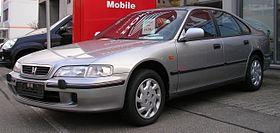 | |
| Overview | |
| Also called | Honda Ascot Innova |
| Production | 1993–1998 |
| Assembly | Swindon, England (HUKM) |
| Designer | Shigeo Ueno (1989)[36] |
| Body and chassis | |
| Class | Mid-size car |
| Body style | 4-door sedan |
| Related | Rover 600 |
| Powertrain | |
| Engine | 1.8 L F18A3 I4 2.0 L F20Z I4 2.2 L F22Z2 I4 2.3 L H23A3 I4 2.0 L Rover 20T2N I4 diesel |
| Dimensions | |
| Wheelbase | 2,720 mm (107 in) |
| Length | 4,675 mm (184 in) |
| Width | 1,715 mm (68 in) |
| Height | 1,380 mm (54 in) |
| Curb weight | 1,240–1,375 kg (2,734–3,031 lb) |
The fifth generation Accord for the European market was unveiled in 1993 and was not related directly to the North American 'CD' Accord. It was in fact the Japanese-market Honda Ascot Innova which was based on the previous fourth generation 'CB' Accord. It was the result of a joint effort with the Rover Group that provided Rover with the 600 series. The exterior was designed by Shigeo Ueno in 1989.
In 1996, the European Accord received a minor facelift and was given a new front end (new headlamps, bumper, hood and grill) and slightly different taillamps (see images). The styling of the facelifted Accord remained identical to the styling of the Ascot Innova (although the frameless doors were replaced with conventional items) and featured the design language first introduced on the 5th generation Honda Civic. The styling of the European Accord differed dramatically from the North American which featured a more conventional sedan styling compared to the European model's low slung, fastback inspired look which also incorporated rear quarter windows. The facelifted Accord was also equipped with two airbags as standard.
However, the European Accord did not spawn an station wagon nor a coupe version, Honda instead opting to import the coupe and station wagon (Aerodeck) versions of the North American Accord.
The diesel model of the Accord was fitted with the direct injection Rover L-Series diesel engine, as also fitted in the Rover 600.
Rover 600[edit]
As part of the tie-up with the Rover Group the European Accord spawned Rover's replacement for the Austin Montego in 1993. Called the 600, the car shared its platform with the European Accord and, with the exception of the front doors, lower rear doors and windscreen, sported unique styling which dispensed with the rear quarter windows. The interior design of the 600 was very similar to the Accord's however, while the dashboard design was identical.
Sixth generation (1997–2002)[edit]
For the sixth generation, Honda split the Accord into three separate models, designed for the Japanese, North American, and European markets. However, the wagon was discontinued in North America while the coupe was discontinued in Japan. This generation also spawned two distinctively branded performance versions for European and Japanese domestic markets, dubbed Type R and Euro R, respectively.
On the origin of these models, it is rumored[37] that with the advent of the sixth generation Accord, "Honda England were let loose to build a car that would compete with Subaru's Impreza, and Mitsubishi's Evo. They came up with the Accord Type R, a lightened (1200 kg) track version with no sound deadening and few luxuries(listed below)". Honda Japan followed suit in 2000, "took the Accord Type R and developed the Accord Euro-R (hence the 'Euro'pean tag)" which has a double wishbone front and 5-link rear suspension system, stiffer suspension and chassis, Helical limited-slip-differential, twin-piston brakes, dual twin silencer exhaust system, 16-inch alloy wheels, A exclusive "red-top" engine cover, white badged Euro-R meters, a strut tower bar, an exclusive Euro-R aluminum shift knob, high-intensity discharge (HID) headlamps, fog lights, body colored retractable electric door mirrors, power windows, key less entry, air conditioning, driver and passenger SRS air bags, and ABS.Recaro seats and a leather-trimmed Momo steering wheel. As an option, there was a distinctive tall and functional rear spoiler wing that most customers opted for. The Accord Type-R featured 209 bhp (212ps, 155.9Kw) @ 7,200 rpm and 164 lb·ft (222 N·m) @ 6,700, while the Euro-R variant featured an improved H22A engine with 217 bhp (220ps, 161.8Kw) @7200 rpm and 164 lb-ft(220-Nm)@5500rpm. Apart from an improved H22A engine, Euro-R badged meters, and exclusive Euro-R aluminum shift knob, The JDM Accord/Torneo Euro-R and Accord Type-R are very similar. The Accord/Torneo Euro-R was later succeeded by the seventh generation Accord Euro-R, see article below for details.
Seventh generation (2002–2007)[edit]
The seventh generation of the Accord was launched in 2002 (2003 model year in North America),[38] and consists of two separate models; one for the Japanese and European markets, and the other for North America, with the Japanese and European model being sold in North America as the Acura TSX. However, both were in fact sold in many other markets, fueled by the popular Cog advertisement for the Accord. Euro R trim continued into this generation as performance model for Japanese market, making use of K20 engine producing 220 hp, however, European performance model was renamed Type S and used larger K24 engine tuned to produce 190 hp.
Japan and Europe[edit]
The European and Japanese Accords were integrated on the previous Japanese Accord's chassis, but with a new body.[39] No longer made in Swindon, those Accords were made in Japan, and came in both sedan and station wagon form.
At its introduction in 2003, it won the Car of the Year Japan Award for a record third time. In Europe the car featured a 2.0 i-VTEC with 152BHP, a 2.4 i-VTEC with 187BHP, and an "exceptional"[40] 2.2 i-CDTi turbo diesel engine with initially 138BHP and 340Nm of torque, while doing 51MPG on the EU combined cycle.
This model was sold in certain markets such as Fiji, Australia and New Zealand as the "Accord Euro" and in North America as the Acura TSX, with a significant distinction being that the TSX featured the interior of the contemporary Honda Inspire instead.[39]
Accord Euro R (CL7, 2002–2007)[edit]
The Honda Accord Euro R (CL7) was launched in October 2002, succeeding the previous Euro R (CL1). A lightened and more sports focused variant of the Japanese car the Accord Euro R was powered by the K20A 2.0L DOHC i-VTEC engine producing 220 bhp (217 hp, 162 kW @ 8000 rpm) and 21.0 kg-m (206 Nm @ 7000 rpm) of torque through the only option of a lightweight 6-speed manual transmission. The same engine can be found in the JDM Integra Type R (DC5). The Accord Euro-R was available to the Japanese Domestic Market and Europe. Some features that distinguish it are the Recaro seats, the body kit, a MOMO steering wheel, lightweight 17-inch alloys and a special aluminum gearknob found only in Honda's Type R variants.
North America and Asia Pacific[edit]
The North American Accord grew in size yet again, becoming a vastly different car than its Japanese and European counterpart. This generation was available in both coupe and sedan forms, while a hybrid model was introduced in early 2005.[41] For 2006, it was significantly updated.
This Accord was the first to use wheels with five lug nuts instead of the traditional four on 4-cylinder models. The 4-cylinder version came with 161 horsepower (120 kW) and 160 pound-feet (220 N⋅m) (166 horsepower (124 kW) and 161 pound-feet (218 N⋅m) for 2005–2007 models) K24A1 2397 cc 4-cylinder engine mated to a 5-speed automatic or 5-speed manual. The 4-cylinder engine also utilized a timing chain instead of a timing belt.[42]
For 2003, Honda began to offer a more aggressive Accord Coupe, equipped with the 240 horsepower (180 kW) and 212 pound-feet (287 N⋅m) (244 horsepower (182 kW) and 211 pound-feet (286 N⋅m) for 2006–2007 models) J30A4 2997cc V6 mated to a 6-speed manual transmission borrowed from the Acura TL Type S (without a limited slip differential). This coupe came with 17-inch wheels (that varied between the 03-05 and 06-07 models), strut tower bar, perforated leather seating, carbon fiber dash pieces, and an upgraded 180-watt stereo system. Because of the ability to maintain activation of the VTEC system all the way through hard acceleration, the Accord EX V6 6-speed ran from 0–60 MPH in just 5.9 seconds according to Car and Driver, more than a second faster than the automatic version.
This model was also sold in Japan as the Honda Inspire from 2003 to 2008. In China, the model got the name Guangzhou-Honda Accord and was sold from 2003 up to December 2009.
The National Highway Traffic Safety Administration (NHTSA) has crash test ratings of Accord of different model years:[43]
| Model year | Model | Type | Front driver | Front passenger | Side driver | Side passenger | 4x2 rollover |
|---|---|---|---|---|---|---|---|
| 2003 | Accord | 4dr | |||||
| 2004 | Accord | 4dr w/SAB | |||||
| 2005 | Accord | 2dr w/SAB | |||||
| 2006 | Accord | 4dr w/SAB | |||||
| 2007 | Accord | 2dr w/SAB |
The Insurance Institute for Highway Safety found 2003–04 Accords had the lowest fatality rates in the non-luxury midsize sedan class[44]
Eighth generation (2007–2012)[edit]
Accord in Japan and Europe and Spirior in China[edit]
The updated Accord for the Japanese and European markets went on sale in mid-2008. It is also sold as the Accord Euro in the Australia and New Zealand markets, and as the Acura TSX in North America. It is available as both a sedan and a station wagon. In the People's Republic of China, a version of the sedan is sold as the Honda Spirior which later on developed an independent second generation. Production started in August 2009 in China, by Dongfeng Honda. Production ended at the end of February 2015 for Australia and New Zealand spec models.
In Europe, the car maintained the 2.0 and 2.4 i-VTEC gasoline (upped to 156 and 198BHP respectively), whilst a new 2.2 i-DTEC diesel engine provided 147BHP/ 258 ft/lbs in standard trim levels, and 177BHP/ 280 ft/lbs in Type-S sports trim level. This allowed the Accord to go 0–100 in 8.5 seconds, and still do 50MPG on the EU Combined cycle.[45] Sales in Europe were discontinued in 2015.
Accord in North America and China and Inspire in Japan[edit]
The North American version of the Accord has a different body from its Japanese counterpart. This shape is sold as the Honda Inspire in Japan, and is not sold in Europe. It was discontinued in Japan in September 2012.[citation needed] Larger than the previous model, the sedan is now classified as a full-size car by EPA standards. A coupe version is available, as well as a Crosstour fastback model, which was introduced in the US for the 2010 model year.[46] Engines include a 2.4 Liter 4-cylinder rated at 177 bhp (132 kW) with 161 lb⋅ft (218 N⋅m) for Lx-Se sedans and 190 bhp (142 kW) with 162 lb⋅ft (220 N⋅m) for EX-Ex-l and LX-S sedans and coupes; as well as a 3.5 Liter V6 rated at 272 bhp (203 kW) and 254 lb⋅ft (344 N⋅m).
In Australia, New Zealand, Sri Lanka, India, Thailand, Indonesia and Singapore, this car which is assembled in Thailand, is sold as the Accord in left or right hand drive forms. In Malaysia, the Accord is locally assembled. In Hong Kong, this car is made in Japan and sold as the Accord, and in Taiwan, the Accord is locally assembled. In China, Guangqi Honda also makes this vehicle with 2.0L, 2.4L and 3.5L engines. Guangqi began making the Accord Crosstour in 2010.
In Malaysia, the eighth generation is also rebadged as the Proton Perdana from December 2013 and is used by government officials. It is assembled at the Honda-DRB plant in HICOM Industrial Park Pegoh, Alor gajah, Melaka.
Ninth generation (2013-2017)[edit]
For the ninth-generation Accord, Honda appointed Shoji Matsui, who served as an engineer on the Accord platform from 1985 to 1996, as lead project manager. It is the first Honda vehicle to be completely developed under the administration of Honda CEO Takanobu Ito.
Honda revealed the Accord Coupe Concept at the 2012 North American International Auto Show in Detroit. In August 2012, the company released initial details pertaining to the 2013 Accord sedan, and production versions of both the sedan and coupe were fully unveiled in early September 2012.[47] The Accord sedan went on sale on 19 September 2012 in the United States, with the coupe following on 15 October. Corresponding release dates in Canada for the sedan and coupe models are 24 September 2012 and 1 November 2012, respectively. In February 2013, the Accord was scheduled to enter the Russian market.[48] In June 2013, the Accord hybrid and plug-in hybrid were introduced to the Japanese market, with the discontinuation of the Honda Inspire, serving as Honda's large sedan and one level below the Honda Legend.
From 2014, Honda exports the Accord from China to the Middle and Near East, Africa, members of CIS, and others.[49] While replaced by the tenth generation in late 2017, the ninth Accord continued to be built in Thailand until 2019 in most right hand drive markets.
Tenth generation (2018–present)[edit]
| Tenth generation [CV1/CV2/CV3] | |
|---|---|
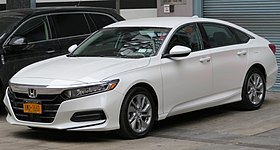 2018 Accord LX | |
| Overview | |
| Also called | Honda Inspire (Dongfeng Honda) |
| Production | September 2017–present (North America) March 2019–present (Asia) |
| Model years | 2018–present (North America) |
| Assembly | Marysville, Ohio (Marysville Auto Plant) Guangzhou, China (Guangqi Honda) Ayutthaya, Thailand |
| Designer |
|
| Body and chassis | |
| Class | Mid-size car |
| Body style | 4-door sedan |
| Powertrain | |
| Engine |
|
| Transmission | |
| Dimensions | |
| Wheelbase | 2,830 mm (111 in) |
| Length | 4,882 mm (192.2 in) |
| Width | 1,862 mm (73.3 in) |
| Height | 1,451 mm (57.1 in) |
| Curb weight | 1,420–1,555 kg (3,131–3,428 lb) |
The tenth generation Accord was unveiled on July 14, 2017.[51] Production began on September 18, 2017, and sales began on October 18, 2017 in the United States as a 2018 model.[52] It was also released in Canada on October 27, 2017.[53] The vehicle is equipped with standard Honda Sensing on all models, and a base 1.5 L VTEC Turbo four-cylinder engine that produces 143 kW (192 hp; 194 PS) and 260 N⋅m (190 lbf⋅ft) of torque, mated to a 6-speed manual or continuously variable transmission (CVT).[54] The optional 2.0 L VTEC Turbo four-cylinder engine, which replaced the V6 engine option, was available beginning December 2017. This engine is based on the design of the engine offered in the Civic Type R, but with a smaller turbocharger and more conventional camshaft.[55] The engine, which produced 188 kW (252 hp; 256 PS) and 370 N⋅m (270 lbf⋅ft) of torque is mated to a 6-speed manual or 10-speed automatic transmission.[56] With this generation, the Accord is now exclusively offered as a four-door sedan, the coupe variant being discontinued.
The ASEAN (Southeast Asian) market tenth-generation Accord debuted on November 28, 2018 at the Thailand International Motor Expo.[57] It was launched in Thailand on March 19, 2019.
Awards[edit]
- Motor Trend's "Import Car of the Year" for 1994.[58]
- Car and Driver's recipient of the 10 Best in recognition for 31 of the last 35 years.[59][60][61]
- Voted "Car of the Year Japan" in 1985, 1993 and 2002.[62]
- 2008 Drive's "Car of the Year".[63]
- South African Car of the Year 2009[64]
- The JB car pages awarded the 2008 – 2011 Accord a best-in-class 4 1/2 Star rating.[65]
- 2013 Canadian Car of the Year
- 2014 Green Car of the Year.[66]
- 2018 North American Car of the Year [67]
- 2018 Canadian Car of the Year [68]
Motorsport[edit]
The Accord Euro R was used in the 2008 World Touring Car Championship season and the 2009 European Touring Car Cup, and won the 1996 Japanese Touring Car Championship season and the 1997 British Touring Car Championship season. The 3 Crowns Racing team were the champions of the 2004 Asian Touring Car Series, and Golden Motors won the 2007 Russian Touring Car Championship. Driver Matt Dooley posted an impressive 10 minutes 36 seconds on a 12-mile portion of NC-80, also known as The Devil's Whip, on 28 March 2013. The road was closed for the event.
| Year | Championship | Result |
|---|---|---|
| 1996 | Japanese Touring Car Championship | 1 |
| 1996 | British Touring Car Championship | 5 |
| 1996 | North American Touring Car Championship | 1 |
| 1997 | Japanese Touring Car Championship | 1 |
| 1997 | British Touring Car Championship | 3 |
| 1998 | British Touring Car Championship | 4 |
| 1999 | British Touring Car Championship | 2 |
| 1999 | Super Tourenwagen Cup | 3 |
| 2000 | British Touring Car Championship | 2 |
| 2004 | Asian Touring Car Series | 1 |
| 2006 | World Touring Car Championship | 3 |
| 2007 | Russian Touring Car Championship | 1 |
| 2008 | World Touring Car Championship | 4 |
| 2008 | Italian Superturismo Championship | 1 |
| 2008 | Swedish Touring Car Championship | 2 |
| 2009 | European Touring Car Cup | 1 |
| 2010 | European Touring Car Cup | 1 |
| 2011 | European Touring Car Cup | 1 |
| 2012 | European Touring Car Cup | 6 |
Competition[edit]
It's major competitors include Toyota Camry, Nissan Altima, Hyundai Sonata, Chevrolet Malibu, Volkswagen Passat, Subaru Legacy, Ford Fusion, Mazda6 and Kia Optima.
Sales[edit]
| Honda Accord sales in the US, 1976–present | ||||||||||||||||||||||||||||||||||||||||||||||||||||||||||||||||||||||||||||||||||||||||||||||||||||||||||||||||||||||||||||||||||||||||||||
|---|---|---|---|---|---|---|---|---|---|---|---|---|---|---|---|---|---|---|---|---|---|---|---|---|---|---|---|---|---|---|---|---|---|---|---|---|---|---|---|---|---|---|---|---|---|---|---|---|---|---|---|---|---|---|---|---|---|---|---|---|---|---|---|---|---|---|---|---|---|---|---|---|---|---|---|---|---|---|---|---|---|---|---|---|---|---|---|---|---|---|---|---|---|---|---|---|---|---|---|---|---|---|---|---|---|---|---|---|---|---|---|---|---|---|---|---|---|---|---|---|---|---|---|---|---|---|---|---|---|---|---|---|---|---|---|---|---|---|---|---|
|
|
| ||||||||||||||||||||||||||||||||||||||||||||||||||||||||||||||||||||||||||||||||||||||||||||||||||||||||||||||||||||||||||||||||||||||||||
| Source: "Honda Digital Factbook". | ||||||||||||||||||||||||||||||||||||||||||||||||||||||||||||||||||||||||||||||||||||||||||||||||||||||||||||||||||||||||||||||||||||||||||||
References[edit]
- ^ "2008 Honda Accord Review". JB car pages. Retrieved 3 April 2011.
- ^ "2008 Honda Accord Overview". Honda. Archived from the original on 17 October 2007. Retrieved 12 December 2010.
- ^ Jump up to: a b Wolfcale, James. "The Top Ten Hondas of All Time". DriveCult. Retrieved 26 September 2012.
- ^ "Accord—Accord, Torneo, Accord Wagon" (Press release). Honda. 4 September 1997. Retrieved 12 December 2010.
- ^ Kießler, Bernd-Wilfried (1992), Daihatsu Automobile: Erfahrung für die Zukunft (in German), Südwest, p. 92, ISBN 9783517012254
- ^ Niedermeyer, Paul. "Curbside Classic: 1976 Honda Accord – Modern Architecture". Curbside Classics. Retrieved 26 September 2012.
- ^ "Introducing the Accord(1976)". Retrieved 17 January 2016.
- ^ Markus, Frank. "Feature Flashback: 1976 Honda Accord". Motor Trend. Retrieved 3 October 2017.
- ^ "2008 Honda Accord vs. 2007 Toyota Camry – Head to Head". Motor Trend. Retrieved 12 December 2010.
- ^ "The 100 most reliable cars of the last decade (in order)". Gizmag.com. 21 May 2006. Retrieved 28 April 2009.
- ^ Siler, Steve. "2016 Honda Accord Sedan". Car and Driver. Retrieved 17 August 2015.
- ^ "Honda Accord Beats Ford Taurus as Top Selling Car of 1989 IN U.S." Deseret News. 26 January 1990. Retrieved 30 August 2014.
- ^ Jump up to: a b c d Leeps (4 June 1989). "Rust Busters". New Straits Times / Google News Archive. Retrieved 3 May 2015.
- ^ von Fersen, Olaf (6 March 1980). "Automobiltechnik an der Zeitenwende/La technique de l'automobile à un tournant" [Automobile technology at a turning point]. Automobil Revue '80 (in German and French). Berne, Switzerland: Hallwag, AG. 75: 105.
- ^ "News". Autocar. 4228 (147): 16–17. 19 November 1977.
- ^ Jump up to: a b Hogg, Tony (ed.). "1981 Buyer's Guide". Road & Track's Road Test Annual & Buyer's Guide 1981 (January–February 1981): 99.
- ^ US D272137
- ^ "Honda Accord History". Edmunds.com. 26 February 2010. Retrieved 2 September 2012.
- ^ Jump up to: a b Hogsten, Dag E. (1982-08-11). "Dubbelspel" [Double-deal]. Teknikens Värld (in Swedish). Vol. 34 no. 17. Stockholm, Sweden: Specialtidningsförlaget AB. pp. 29–30.
- ^ "Old School JDM Sat-Nav". grandJDM. Archived from the original on 28 September 2009. Retrieved 12 December 2010.
- ^ 自動車ガイドブック [Japanese Motor Vehicles Guide Book 1983-84] (in Japanese), 30, Japan: Japan Automobile Manufacturers Association, 1983-10-28, pp. 216–217, 0053-830030-3400
- ^ Automobile Guide Book 1983-84, p. 159
- ^ 自動車ガイドブック [Japanese Motor Vehicles Guide Book 1984~'85] (in Japanese), 31, Japan: Japan Automobile Manufacturers Association, 1984-10-20, p. 112, 0053-840031-3400
- ^ As quoted in Japanese market sales brochure for the Accord
- ^ Japanese television commercial for the Aero Deck.
- ^ [1] Archived 8 August 2014 at the Wayback Machine
- ^ Taylor III, Alex (10 September 1990). "Japan's new U.S. car strategy". CNN. Archived from the original on 16 April 2014. Retrieved 30 August 2014.
- ^ Ben D'Cunha (26 December 1993). "In accord with success". New Straits Times / Google News Archive. Retrieved 3 May 2015.
- ^ "A Car Is Born". Bloomberg BusinessWeek. 12 September 1993. Retrieved 30 August 2014.
- ^ "Patent USD347806 – Automobile – Google Patents". Google. Retrieved 2 September 2012.
- ^ Andres, Anton. "40 years of Honda Accord (Jul 14, 2016)". Autoindustriya.com. Retrieved 29 December 2016.
- ^ "Hot Wheels". nicb.org/. Retrieved 2 September 2012.
- ^ Yamaguchi, Jack; Road&Track Magazine, December 1993 Ampersand-Letter from Japan "The Pride of Marysville and its Japanese Siblings" p53
- ^ "Honda Accord History". world.honda.com. Archived from the original on 11 December 2015. Retrieved 30 March 2016.
- ^ Yamaguchi, Jack; Road&Track Magazine, July 1994 Ampersand "Eagles are landing in Japan" p64-67
- ^ "Patent USD347805 – Automobile – Google Patents". Google. Retrieved 26 July 2014.
- ^ "Accord Type R or Euro R? – Page 2". Honda-Tech. Retrieved 26 July 2014.
- ^ "Honda Accord Reviews". JB car pages. Retrieved 3 April 2011.
- ^ Jump up to: a b "Acura TSX Reviews". JB car pages. Retrieved 3 April 2011.
- ^ "Honda sedan". Parkers. 29 July 2013. Retrieved 26 July 2014.
- ^ "2005 Honda Accord, Review". JB car pages. Retrieved 3 April 2011.
- ^ "? on Honda Accord 4cyl timing chain yrs". Retrieved 20 September 2013.
- ^ "1990–2010 Search Results by Model". NHTSA.GOV. Retrieved 17 March 2011.
- ^ [2] Archived 15 September 2012 at the Wayback Machine
- ^ "Honda Accord sedan 2.2 i-DTEC TYPE-S 4d – Facts and Figures". Parkers. 29 July 2013. Retrieved 26 July 2014.
- ^ "2010 Honda Accord Crosstour Preview". JB car pages. Archived from the original on 19 July 2012. Retrieved 3 April 2011.
- ^ "Honda Accord: The Ninth Generation" (Press release). American Honda Motor. 5 September 2012. Retrieved 10 April 2016.
- ^ "New Accord Will Hit Russia in February 2013". Archived from the original on 2012-10-13.
- ^ "Successful Shipment of Accord by Honda Automobile (China) Co., Ltd". Honda Automobile (China) Co., Ltd. Retrieved 9 October 2017.
- ^ Jump up to: a b c "Vehicle Specifications | 2018 Honda Accord | Honda Owners Site". American Honda Motor Co., Inc. Retrieved 2018-06-04.
- ^ "2018 Honda Accord World Debut" (Press release). American Honda Motor. July 18, 2017. Retrieved 15 July 2017.
- ^ Rosevear, John (18 October 2017). "Honda Sharpens Its All-New 2018 Accord to Steal SUV Sales". The Motley Fool. Retrieved 3 December 2017.
- ^ "Completely Redesigned 2018 Honda Accord to Arrive At Dealerships This Fall". Cambridge center Honda. 6 October 2017. Retrieved 3 December 2017.
- ^ "2018 Honda Accord Press Kit - Powertrain - Honda.com". news.honda.com. Retrieved 2018-04-18.
- ^ "A Tale of Two 2.0-Liters: Comparing the Turbo Four in Honda's New Accord and the Civic Type R | News | Car and Driver". Car and Driver. Retrieved 2018-04-18.
- ^ "2018 Honda Accord Press Kit - Powertrain - Honda.com". news.honda.com. Retrieved 2018-04-18.
- ^ https://paultan.org/2018/11/29/new-honda-accord-previewed-in-thailand-2019-launch/
- ^ "Motor Trend Import Cars of the Year Complete Winners List". Motor Trend. Retrieved 28 April 2009.
- ^ "2009 10Best Cars – 10Best Cars/Best/Worst Lists/High Performance/Hot Lists/Reviews/Car and Driver". Car And Driver. 23 March 2008. Archived from the original on 24 July 2009. Retrieved 28 April 2009.
- ^ "2010 10Best Cars – 10Best Cars – Auto Reviews". Car and Driver. Archived from the original on 12 September 2010. Retrieved 15 October 2010.
- ^ "2014 10Best Cars". Car And Driver. November 2013. Retrieved 1 April 2014.
- ^ "日本カー・オブ・ザ・イヤー 2008–2009 公式サイト". Jcoty.org. Retrieved 28 April 2009.
- ^ "DCOTY 2008: The Overall Winner – Honda Accord V6". Drive.com.au. Archived from the original on 24 February 2013. Retrieved 28 April 2009.
- ^ "Honda Accord Wins SA Car of the Year 2009". SACarFan.co.za. Archived from the original on 25 March 2009. Retrieved 12 May 2011.
- ^ "Honda Accord Reviews & News". JB car pages. Retrieved 3 April 2011.
- ^ Priddle, Alisa (21 November 2013). "Honda Accord named Green Car of the Year". USA Today. Retrieved 22 November 2013.
- ^ "The North American Car, Utility and Truck of the Year Awards Names Honda Accord, Volvo XC60, LINCOLN Navigator 2018 Winners". northamericancaroftheyear.org. Retrieved 2018-01-19.
- ^ "AJAC Announces the 2018 Canadian Car of the Year and 2018 Canadian Utility Vehicle of the Year". newswire.ca. Retrieved 2018-02-21.
External links[edit]
| Wikimedia Commons has media related to Honda Accord. |
| show « previous — Honda road car timeline, 1980s–present
|
|---|
| hide Honda road car timeline, North American market, 1980s–present
| |||||||||||||||||||||||||||||||||||||||||
|---|---|---|---|---|---|---|---|---|---|---|---|---|---|---|---|---|---|---|---|---|---|---|---|---|---|---|---|---|---|---|---|---|---|---|---|---|---|---|---|---|---|
| Type | 1980s | 1990s | 2000s | 2010s | |||||||||||||||||||||||||||||||||||||
| 0 | 1 | 2 | 3 | 4 | 5 | 6 | 7 | 8 | 9 | 0 | 1 | 2 | 3 | 4 | 5 | 6 | 7 | 8 | 9 | 0 | 1 | 2 | 3 | 4 | 5 | 6 | 7 | 8 | 9 | 0 | 1 | 2 | 3 | 4 | 5 | 6 | 7 | 8 | 9 | ||
| Subcompact | Insight | ||||||||||||||||||||||||||||||||||||||||
| Civic | Civic | Civic | Civic | Civic | Fit | Fit | Fit | ||||||||||||||||||||||||||||||||||
| Compact | Insight | Insight | |||||||||||||||||||||||||||||||||||||||
| Accord | Accord | Accord | Accord | Civic | Civic | Civic | Civic | ||||||||||||||||||||||||||||||||||
| Mid-size | Accord | Accord | Accord | Accord Coupe | Accord | Accord | |||||||||||||||||||||||||||||||||||
| Clarity | |||||||||||||||||||||||||||||||||||||||||
| Full-size | Accord Sedan | ||||||||||||||||||||||||||||||||||||||||
| Coupe | Prelude | Prelude | Prelude | Prelude | Prelude | ||||||||||||||||||||||||||||||||||||
| Sport compact | CR-X | CR-X | del Sol | CR-Z | Civic Type R | ||||||||||||||||||||||||||||||||||||
| Sports car | S2000 | ||||||||||||||||||||||||||||||||||||||||
| Crossover | Mini | HR-V | |||||||||||||||||||||||||||||||||||||||
| Compact | Element | ||||||||||||||||||||||||||||||||||||||||
| CR-V | CR-V | CR-V | CR-V | CR-V | |||||||||||||||||||||||||||||||||||||
| Mid-size | Crosstour | Passport | |||||||||||||||||||||||||||||||||||||||
| Pilot | Pilot | Pilot | |||||||||||||||||||||||||||||||||||||||
| Sport utility vehicle | Passport | Passport | |||||||||||||||||||||||||||||||||||||||
| Minivan | Odyssey | Odyssey | Odyssey | Odyssey | Odyssey | ||||||||||||||||||||||||||||||||||||
| Pickup truck | Ridgeline | Ridgeline | |||||||||||||||||||||||||||||||||||||||
- Honda vehicles
- Cars introduced in 1976
- Compact cars
- Coupés
- Euro NCAP large family cars
- Front-wheel-drive vehicles
- Full-size vehicles
- Mid-size cars
- Motor vehicles manufactured in the United States
- Plug-in hybrid vehicles
- Sedans
- Station wagons
- Touring cars
- Vehicles with four-wheel steering
- 1980s cars
- 1990s cars
- 2000s cars
- 2010s cars

.svg.png)
.jpg)
.jpg)
.jpg)
.jpg)
_(13489425163).jpg)
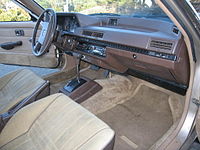
_01.jpg)
_02.jpg)

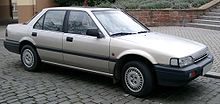
.jpg)

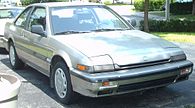
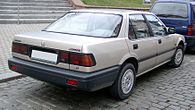
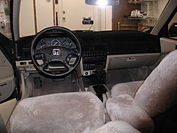
_(5170004213)_(cropped).jpg)
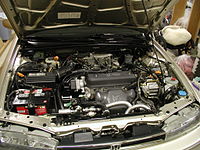

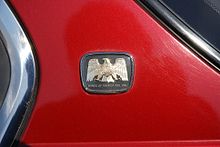
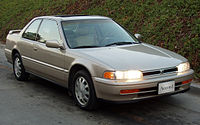
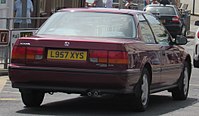
_sedan_(2010-07-22).jpg)

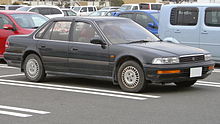




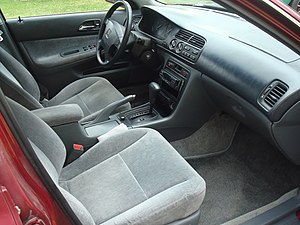


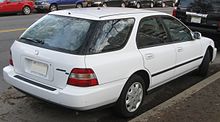

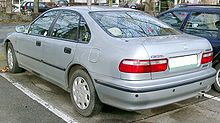

_01.jpg)
_02.jpg)
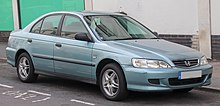
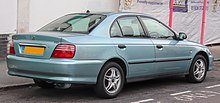
.jpg)
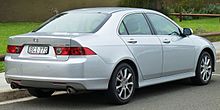
_01.jpg)
.jpg)
_01_(cropped).jpg)
_02.jpg)
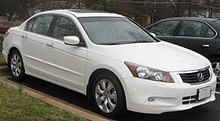
_rear_20100925.jpg)
_01.jpg)
_02.jpg)
_VTi_sedan_(2017-03-25).jpg)
,_2017,_USA.jpg)

